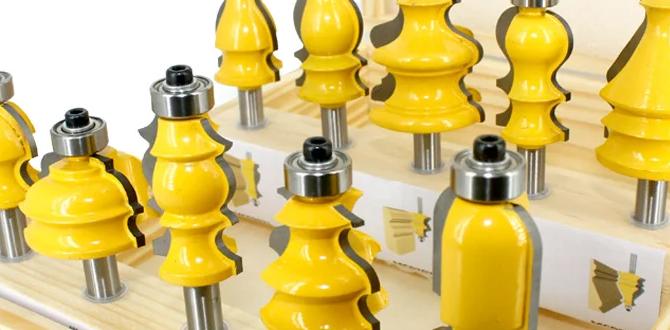A 1/8″ carbide end mill for HRC60 is your go-to for precise machining of hardened steels, offering durability and clean cuts in your milling projects. It’s the smart choice for intricate work on tough materials.
Welcome to Lathe Hub, where we make machining accessible for everyone! Ever found yourself staring at a block of tough hardened steel, wondering how to tackle it without ruining your tools? It’s a common challenge for new machinists. You want to achieve those clean, precise cuts, but the material seems unforgiving. Don’t worry, this is where the right tool makes all the difference. Today, we’re diving deep into a specific hero of the workshop: the 1/8″ carbide end mill designed for HRC60. We’ll break down exactly why this tiny but mighty tool is an essential choice for working with hardened metals and how you can use it confidently. Get ready to demystify this key piece of equipment and boost your machining skills!
Why a 1/8″ Carbide End Mill for HRC60 is an Essential Choice
When you’re working with metal, especially hardened steel, the right cutting tool isn’t just helpful – it’s absolutely critical. Think of it like trying to chop wood with a butter knife versus a sharp axe; the axe (the right tool) makes the job easier, faster, and much cleaner. That’s precisely where our focus today, the 1/8″ carbide end mill for HRC60, shines. This isn’t just another cutting tool; it’s a specialized instrument designed to conquer some of the toughest materials you’ll encounter in a workshop.
Hardened steel, often rated at HRC60 (which stands for Rockwell hardness scale), is incredibly resistant to wear and deformation. This makes it perfect for tools, bearings, and high-stress components. However, machining it presents a significant challenge. Softer steels or aluminum might be more forgiving, but HRC60 requires tools that can withstand extreme heat and abrasion without dulling or breaking. Enter carbide.
Carbide, specifically tungsten carbide, is a super-hard material that is significantly harder and more rigid than high-speed steel (HSS). This superior hardness allows it to cut through tough materials like HRC60 steel that would quickly chew up and destroy an HSS end mill. When you pair this hardness with the precision of a 1/8″ diameter, you get a tool capable of intricate detail work on exceptionally hard metals.
The Power of Carbide
Carbide cutting tools offer several key advantages, making them indispensable for demanding machining tasks:
Extreme Hardness: As mentioned, carbide boasts exceptional hardness, allowing it to cut materials that are far too hard for standard HSS tools. This is its primary advantage when dealing with HRC60.
High Rigidity: Carbide is also much stiffer than HSS. This means it deflects less under cutting forces, leading to more accurate and precise cuts. For fine details or tight tolerances, this rigidity is invaluable.
Heat Resistance: Machining generates heat. Carbide can withstand much higher temperatures than HSS without losing its hardness. This allows for faster cutting speeds and longer tool life, especially when cutting hard metals.
Wear Resistance: The inherent hardness of carbide also means it wears down much slower. This translates to more parts machined per tool and consistent performance over time.
Why 1/8″ Diameter? Precision and Control
The 1/8″ (or 3.175mm) diameter is not chosen arbitrarily. This size offers a fantastic balance for several reasons:
Intricate Detail: For creating small features, engraving, or working on miniature projects, a 1/8″ end mill is ideal. It allows for fine-line cutting and access to tight spaces.
Manageable Chip Load: Smaller diameter tools generally require smaller chip loads (the amount of material removed per tooth per revolution). This is crucial when machining hard materials, as it reduces the stress on the tool and the machine, preventing breakage and improving surface finish.
Versatility: While small, a 1/8″ end mill is surprisingly versatile. It can be used for pocketing, profiling, slotting, and even some chamfering or facing operations, depending on the machine’s capabilities and the operator’s skill.
The HRC60 Specification: What It Means for Your Milling
The “HRC60” designation specifically tells you that the end mill is engineered to effectively cut materials hardened to 60 on the Rockwell C scale. Standard end mills might struggle, overheat, or break when attempting to mill HRC60. An end mill rated for HRC60 typically features:
Specific Geometry: The flute geometry, helix angle, and cutting edges are optimized for the forces and heat generated when cutting very hard materials. This often means a lower overall rake angle for increased support behind the cutting edge and a tighter helix to help manage chip evacuation without excessive vibration.
Advanced Coatings: Many carbide end mills designed for hardened steel come with specialized coatings, such as Titanium Nitride (TiN), Titanium Aluminum Nitride (TiAlN), or Aluminum Titanium Nitride (AlTiN). These coatings add another layer of hardness, reduce friction, and improve heat resistance, significantly extending tool life and allowing for more aggressive cutting parameters when appropriate.
So, when you see “Carbide End Mill 1/8″ For HRC60,” you know you’re looking at a tool built for serious work on very tough materials, capable of delivering precision and durability.
Choosing Your First 1/8″ Carbide End Mill for HRC60
For a beginner, stepping into the world of specialized cutting tools can feel a bit overwhelming. But don’t let the jargon scare you! Choosing the right 1/8″ carbide end mill for HRC60 is about understanding a few key features. Think of it as selecting the right paint brush for a delicate portrait versus a broad wall. You need the right tool for the job.
When you’re just starting out, focusing on a few core attributes will help you make a confident purchase. You want a tool that is reliable, performs well, and is forgiving enough for you to learn with.
Key Features to Look For
1. Material: As we’ve discussed, Carbide is non-negotiable for HRC60. Look for “Tungsten Carbide” or simply “Carbide.”
2. Diameter: You’re specifically looking for 1/8 inch. This is crucial for detailed work and manageable chip loads.
3. Shank Diameter: For a 1/8″ end mill, the shank diameter is often the same (1/8″). However, sometimes they come with a slightly larger shank, like a 1/4″ shank, for better rigidity and easier clamping in a vise or collet. For a 1/8″ cutter, a 1/4″ shank can offer a nice balance of stability without being overly cumbersome.
4. Length: End mills come in various lengths. A “standard length” is usually a good starting point. These offer a balance between reach and rigidity. Avoid extra-long or stubby end mills unless you have a specific need for them. A typical 1/8″ end mill might have an overall length of around 2 inches, with a cutting length (flute length) of about 1/2 inch.
5. Number of Flutes: For milling hardened steel, especially at HRC60, you’ll typically see 2-flute or 4-flute end mills.
2-Flute: These are generally preferred for harder materials. They have more clearance between the flutes, which helps with chip evacuation from a smaller diameter cutter. This reduces the risk of the flutes getting clogged with chips, which can lead to tool breakage. They often allow for slightly more aggressive cutting in harder materials if chip evacuation is good.
4-Flute: While great for softer materials or finishing, 4-flute end mills can be more prone to clogging with chips in hard, stringy materials unless you have excellent coolant or air blast. Stick with 2-flute for your first HRC60 cutter.
6. Coating: Look for end mills with a coating. AlTiN (Aluminum Titanium Nitride) or plain TiN (Titanium Nitride) are common and effective for hardened steels. AlTiN is generally better for higher temperatures. A coating adds a protective layer, increasing hardness, reducing friction, and improving heat dissipation.
7. Helix Angle: For hardened materials, a moderate helix angle (often around 30 degrees) is common. This provides a good balance between cutting edge strength and chip clearance.
8. Corner Radius/Chamfer: Some end mills have a sharp corner for square pockets, while others have a slight corner radius or a small chamfer for added strength and to prevent chipping. For general-purpose milling of HRC60, a square end mill (no radius) is often what you’ll start with, but a tiny corner radius (e.g., 0.005″ or 0.010″) can add significant durability.
Recommended Specifications for Beginners
When you’re browsing online or in a tool catalog, aim for something like this:
Type: Carbide End Mill
Diameter: 1/8 inch (0.125″)
Shank Diameter: 1/8 inch or 1/4 inch
Flutes: 2
Coating: AlTiN or TiN
Length: Standard
Application: For Hardened Steel HRC60
Corner: Square or with a very small radius (e.g., 0.005″)
Where to Buy and What to Expect to Pay
You can find these specialized end mills from a variety of sources:
Online Tool Retailers: Websites dedicated to machining tools (like McMaster-Carr, MSC Industrial Supply, Tooltopia, Amazon, eBay) are great places to find a wide selection.
Manufacturer Websites: Many carbide tool manufacturers (e.g., Harvey Tool, YG-1, Marathon, Widia) sell direct or have distributors listed.
For a quality 1/8″ 2-flute carbide end mill with a coating suitable for HRC60, expect to pay anywhere from $15 to $30 USD. While this might seem like a bit of an investment compared to cheaper HSS bits, the longevity and performance on hardened steel make it well worth the cost. Remember, a cheap tool that breaks is far more expensive in the long run due to wasted material, machine downtime, and potential damage.
Mastering the Cut: How to Use Your 1/8″ Carbide End Mill Safely and Effectively
So, you’ve got your shiny new 1/8″ carbide end mill ready to go. That’s fantastic! Now, let’s talk about actually using it to make some chips. Machining hardened steel at HRC60 is different from milling softer materials, but with the right approach, it’s completely manageable. Safety and precision are key here.
Before you even think about turning on the machine, a few preparatory steps are crucial.
1. Proper Workholding is Paramount
This is the golden rule of machining. Your workpiece must be held securely. For small parts and delicate operations with a 1/8″ end mill, consider:
Vise: A good quality milling vise is your best friend. Ensure the workpiece is seated firmly against the vise’s parallels and that the vise jaws have a solid grip. Use a soft jaw insert if you’re worried about marring the surface.
Collet Chuck: For the highest precision and best runout control, a collet chuck with appropriately sized collets is ideal. A 1/8″ end mill fits perfectly into a 1/8″ collet. This ensures the tool runs true without wobbling.
Clamping: For larger pieces or specific setups, T-nuts and clamps can be used. Always ensure they are positioned to avoid interfering with the cutting tool’s path.
Safety Tip: Always position clamps so that if the tool bites or there’s a sudden movement, the clamp will ideally push the workpiece into the vise or fixture, not eject it across the shop.
2. Setting Up Your Machine for Success
Spindle Speed (RPM): This is critical. Carbide tools can run faster than HSS, but there’s a sweet spot. For a 1/8″ carbide end mill in HRC60, you’re generally looking at speeds from 15,000 to 25,000 RPM. The exact speed depends on the specific carbide grade, coating, and the rigidity of your setup. A good starting point for a common AlTiN coated carbide end mill might be around 18,000-20,000 RPM. Always consult the tool manufacturer’s recommendations if available.
Feed Rate (IPM or mm/min): Feed rate is how fast the tool moves through the material. For small end mills and hard materials, you need a relatively light feed rate. A good starting point could be 2-10 inches per minute (IPM) or 50-250 mm/min. Again, this varies greatly. Too fast, and you risk breaking the tool. Too slow, and you might rub the tool and generate excessive heat, dulling it quickly.
Depth of Cut (DOC) and Width of Cut (WOC): This is where a 1/8″ end mill in HRC60 requires respect. You won’t be hogging out large volumes of material quickly.
Depth of Cut (DOC): For full slotting (using the full diameter of the end mill to cut a slot), keep the DOC very shallow – maybe 0.010″ to 0.020″ (0.25mm to 0.5mm). For pocketing (cutting into the surface without going to the full depth of the tool diameter), you might be able to go slightly deeper, but still be conservative.
Width of Cut (WOC): When profiling (cutting around the outside of a shape), typically use a WOC of 0.040″ to 0.080″ (1mm to 2mm). For full slotting, your WOC is your diameter, 1/8″.
Coolant/Lubrication: This is essential for HRC60.
Flood Coolant: The best option if your machine has it. It lubricates, cools, and flushes chips.
Mist Coolant: A good alternative, spraying a fine mist of coolant directly onto the cutting zone.
Cutting Fluid/Oil: Apply a few drops of high-quality cutting fluid directly to the point of contact. Use something specifically designed for hard metals. This is often sufficient for delicate work.
Air Blast: A strong blast of compressed air can help clear chips and provide some cooling, but it’s generally less effective than liquid lubrication for HRC60.
Never try to mill HRC60 dry with a carbide end mill.
3. The Cutting Process: Step-by-Step Example (Pocketing)
Let’s say you want to mill a small pocket in a block of HRC60 steel.
1.






